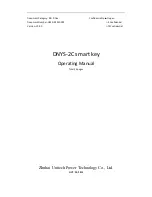
OM-7986
Page 11 of 23
Issue A - Rev 8
Again select the correct acoustic identity on the surface unit and deploy the remote
transducer.
Simultaneously press and hold down for >1 seconds the PROGRAM and BATTERY/LOAD
buttons. ‘
EnbL
’ will be displayed indicating the transponder will be enabled. The first unique
release command will then be sent to the transponder. If the transponder receives the
command it will reply and the range in meters will be displayed and a beep heard.
Again simultaneously press and hold down for >1 seconds the PROGRAM and
BATTERY/LOAD buttons within the 20 second time limit. ‘
Set
’ will be display indicating the
release mechanism will be set. The second release command will be sent, again the
transponder will reply and the range will be displayed.
The surface unit will then automatically send the third unique release command to confirm
the release action, ‘
rEL
-’ will be displayed and then the range in meters. The surface unit
then displays ‘-run’ indicating that the release mechanism is turning, it takes approximately
30 seconds for the nut to be released, the surface will display ‘
donE
’ to indicate the release
is complete.
With all three of the above commands sent if no reply is received from the LRT then the
surface unit will display ‘
FAIL
’. If the final ‘
rEL-
‘ command results in a ‘
FAIL
’ the timer will still
run but will display ‘
----
‘. It is permissible in this circumstance to again press and hold down
the PROGRAM and BATTERY/LOAD buttons to repeat the ‘
Set-
‘ ‘
rEL-
‘ sequence.
The LRT, flotation and mooring should appear at the surface after the 30 second period plus
the time required to rise to surface in the particular water depth.
After ‘
donE
’ is displayed on the surface unit you can repeatedly range to the transponder to
determine its position. Decreasing range will indicate that the LRT and mooring is rising to
the surface. A fixed range may indicate that for some reason the unit has not released
properly, this could be due a number of factors eg snagging of mooring on nets etc or heavy
bio-fouling of the release mechanism.
Attempting to release the LRT two or three more times may help to break the unit off the
bottom.
2.10
Using the Rope Canister
There are rope canister options including 75m, 120m and 160m of high strength recovery
line. The longer lengths of line are of a smaller diameter and have a lower acceptable
recovery load, these loads are stated on the canisters.
As the LRTs release is activated the LRT, rope canister and flotation rise to the surface
deploying the rope from the canister.
The rope canister can be purchase separately from the LRT and fitted in the field.
Attach the rope canister as shown in the drawing with the rope coming out of the hole at the
top of the unit, attached the rope on to the flotation buoys or the top of the LRT.
Coil the rope into the canister a few layers at a time, each time packing down the coils hard
with a suitable ‘rod’. The rope must be packed tightly to fit the full amount of rope into the
canister. Ensure that there are no knots or snags in the rope, as these will reduce the Safe
Working Load rating. Leave approximately 200mm of rope free from the canister.
Ensure that the rope is always terminated with a figure-of-8 loop or a spliced eye. Under high
loads the rope becomes slippery and a bow-line knot etc can slip causing the load to part.












































